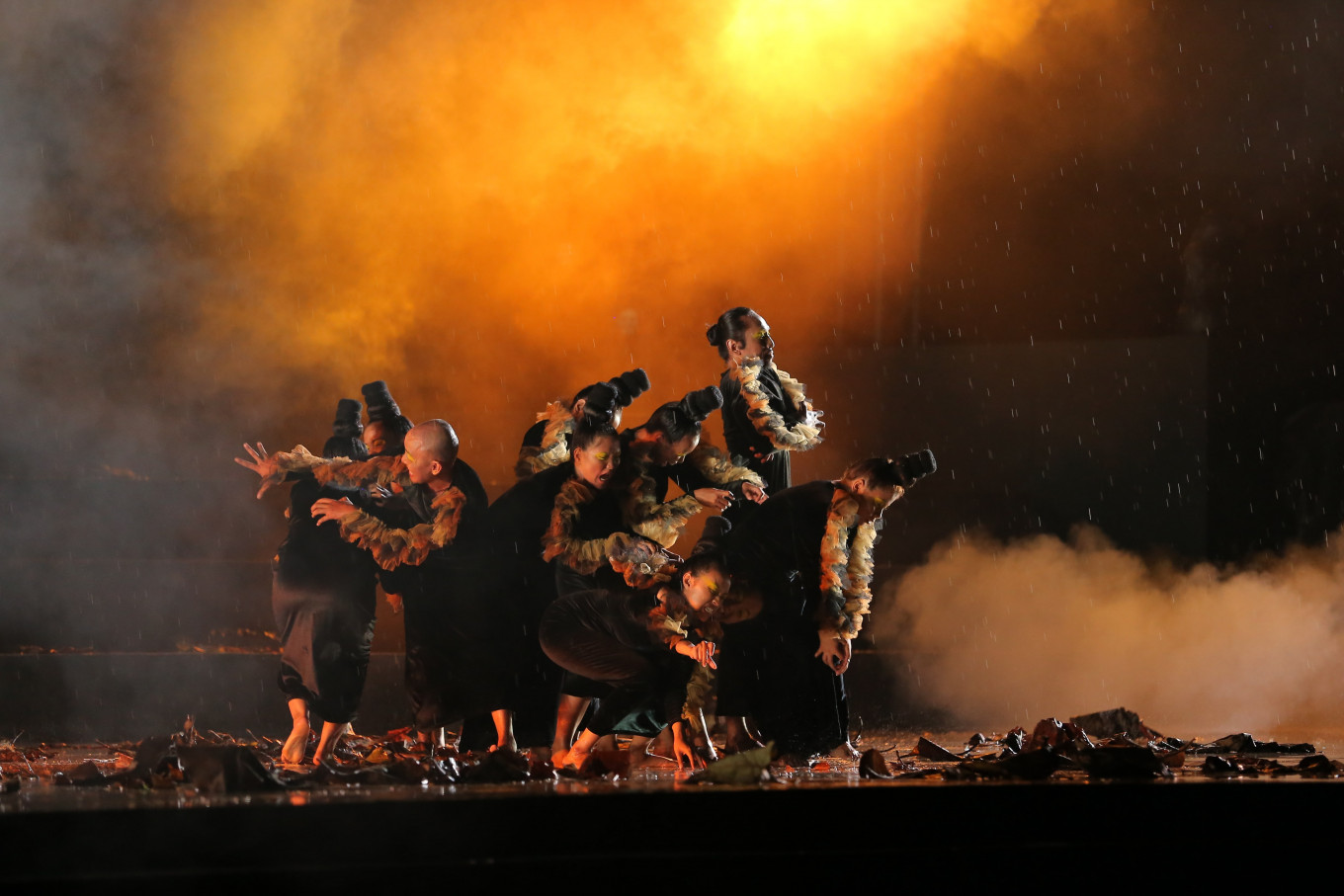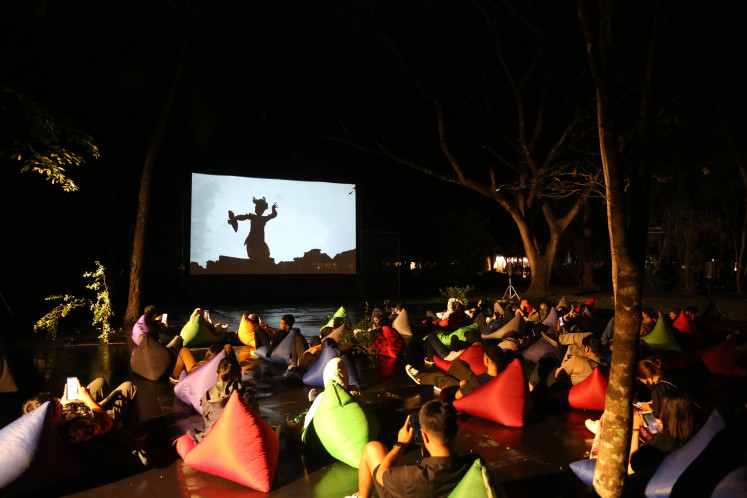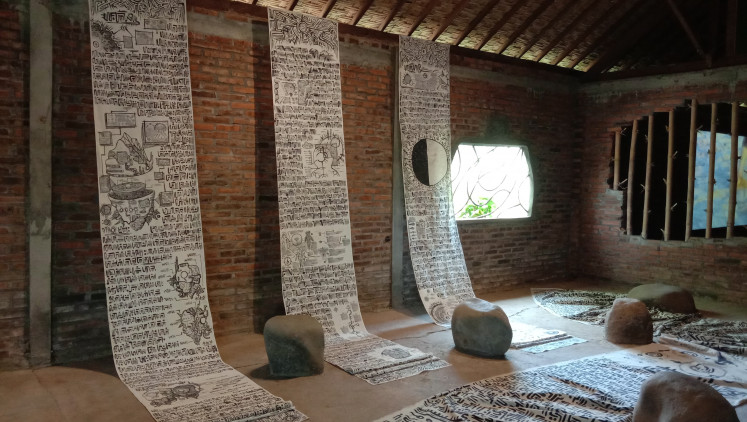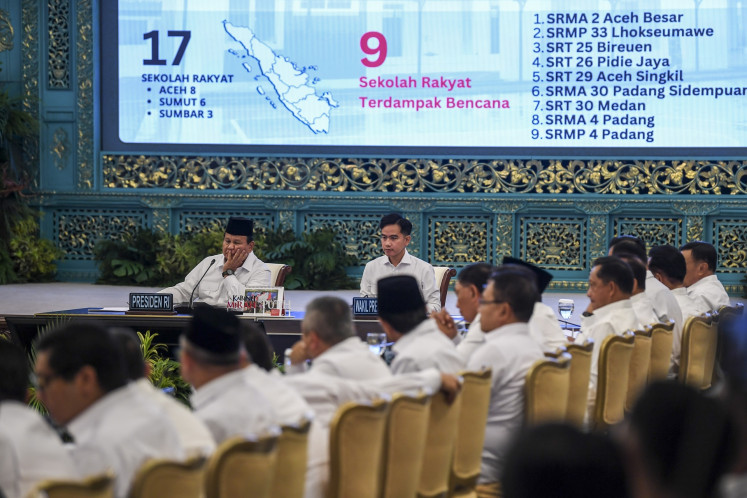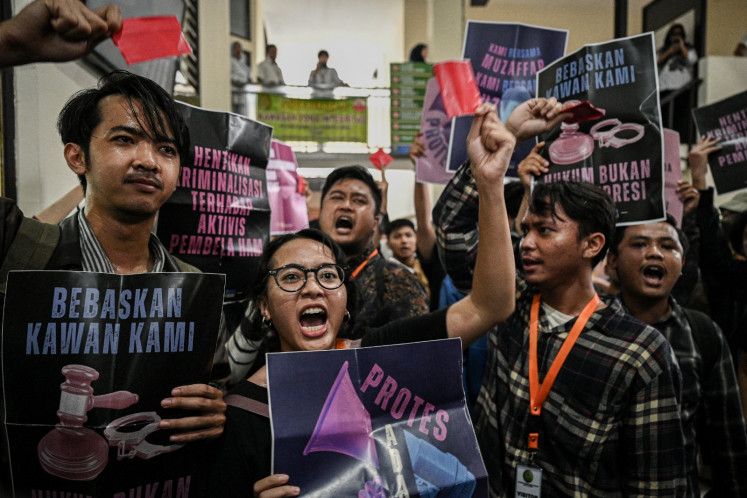Popular Reads
Top Results
Can't find what you're looking for?
View all search resultsPopular Reads
Top Results
Can't find what you're looking for?
View all search resultsIndonesia Bertutur celebrates the past in modern artforms
From video mapping to theatrical showings, artists across disciplines reinterpret Indonesia’s culture at the country’s biggest art exhibition in Magelang, Central Java.
Change text size
Gift Premium Articles
to Anyone
F
rom video mapping to theatrical events, artists across disciplines reinterpret Indonesia’s culture at the country’s biggest art exhibition in Magelang, Central Java.
Right at the merging point of two rivers, high on the ground above, an enraged poet blasted out a stream of praises and prayers as traditional dancers circled around him.
“The Progo river contains the mystery of a long history,” he chanted in Indonesian. “Its clear water reflects the light of the sun. The river runs in a winding stream.”
The monologue was part of the opening of a brand-new art-and-culture festival, Indonesia Bertutur (Indonesia Speaks), kickstarted by the Education, Culture, Research and Technology Ministry and planned to be a biennial event henceforth. It was held in the Magelang regency, Central Java, from Sept. 7 to 13, and for its grand start, local-artist Sucoro orchestrated a water ritual with the art community Brayat Panangkaran at the Eloprogo Art House.
“When we’re talking about Borobudur Temple, it means that we’re also talking about water,” Mbah Coro said to the audience on Sept. 7. Not many people know that Borobudur used to be surrounded by lakes.
The Eloprogo Art House is a landmark that sees two mystical rivers, Elo and Progo, meet. This was one of the places that Indonesia Bertutur chose to highlight because, in the era of endless streaming services and short-lived Twitter trends, it asks the audience: What was our history, and why should cultural remnants exist in the first place?
“Borobudur was initially a place to meditate, to pray,” Mbah Coro said. Now, it has become Indonesia’s biggest tourist attraction instead. “So who is in charge of guarding its spiritual values?”
Making sense of the past
That question lingers in every artwork or performance presented in Indonesia Bertutur. Bearing the theme Experiencing the Past, Cultivating the Future, each artist in the line-up brought the past right into today’s Indonesia -- some in the form of dances, some in carvings and some in a mix of all those things.
“We have a lot of cultural heritage from prehistoric times, classical times, etc. Here, we invite a number of artists to bring them but in new forms, so it's a kind of contemporary response to the past,” Hilmar Farid, the Directorate General of Culture in the Education, Culture, Research and Technology Ministry, said to the media on Sept. 7.
The artists’ responses varied across 116 art installations-slash-performances and four different art spots in Magelang: Limanjawi Art House, Eloprogo Art House, H. Widayat Museum and Apel Watoe Art Gallery. From Khvay Samnang’s dance of two dragons by the river to Natasha Tontey’s digital-geological epoch on the big screen, the art here took extensive forms.
“Rocks are one of the most inorganic materials on this earth, but we often overlook them,” Tontey said to The Jakarta Post on Sept. 7. “Rocks are witnesses of life.”
Her conviction was apparent in her video works, which showed Minahasan communal living and an animated vision of their mythologies that held that the first-ever human was a woman, born out of a rock.
The main event of Indonesia Bertutur, however, occurred in the Borobudur temple area. Musical stars from Tulus to Senyawa swayed the crowd, entertainers Ayo Dongeng Indonesia cheered up the kids with a sing-and-tell story about Borobudur’s reliefs and Prehistoric Body Theater performed a thrilling ode to the ancient Homo erectus people living in Java millions of years ago.
Regardless of the historic theme, the presentations were so imbued with color and futuristic elements. Take Yogyakarta’s collective Teater Garasi, whose acclaimed theater performance Waktu Batu (Stone Time) was rendered into a new version full of vertical screens and even TikTok tunes.
“The first thing that triggered this show in 2002 was the issue of transition. For all of us in Indonesia, the issue of transition was so sharp post ‘98 and early 2000s -- bloody, even,” Yudi Ahmad Tajudin, director of the performance, told the Post.
But for this new version, given the issue of time that followed, Yudi wanted to bring in younger voices to keep the conversation fresh.
“Because the objective is to have a dialogue with today, some of the people we’re taking into the team are young people,” he said, making the performance intergenerational. “One of them was even someone who watched the 2004 version of Waktu Batu in elementary school.”
The rest of the artists used technology and other media to meld past ecosystems into the present day, like Syaiful Aulia Garibaldi’s fungi-invested iron-bars installation and Ade Darmawan’s distillation of various spices in seawater that dripped onto books about the New Order era. The Borobudur temple itself became the futuristic spot for a video mapping of pretty images every night.
“Our culture must not only be told, but also experienced and witnessed, and this festival provides that experience,” Farid further said.
Guarding our cultural values
When the pandemic hit Indonesia in 2020, not only did it paralyze the people and the economy, but also the art scene. This is why Melati Suryodarmo, the artistic director of the event, saw this event as a chance to let the art communities look back and tell the newer generation how culturally rich we are as a nation.
“In Indonesia, there is a lot of history of ‘narrating’, such as narratives about Prambanan, which was a Hindu temple, yes, but then some hundred years later the myth of Roro Jonggrang and Bandung Bondowoso appeared. Amazing, right?” said the revered local artist to the Post.
“So there was a fantasy presented through a new narrative by the local community, just so that they have a sense of respect for the cultural heritage,” she added.
This narrative tendency runs deep in Indonesia and its art world: It was present in the familial presentations at Limanjawi Art House about people, animals and microscopic forms by Umar Chusaeni, Yasumi Ishii and Utami Atasia Ishii. It was also present in the numerous stories about our prehistoric form as humans, one of which was by S. Sophiyah K’s installation of the soils upon which Homo Erectus used to roam -- only it was layered with video mapping, documentaries and even an Instagram filter of the old specimen.
“We’re searching for the traces or remnants [of Homo Erectus] that exist in the body of Sapiens today,” Sophiyah said to the Post on Sept. 8.
“And we highlighted two activities from the people we’ve studied: Hand-holding and walking,” she said, noting that we turned from four-feet-walkers to two-feet-walkers because we started holding a lot of things with our hands.
And the culmination of that reflection on culture was seen in the Ruwatan Bumi (Earth Ceremony) ritual on Sept. 13 -- available for the public only on YouTube livestream -- which involved traditional vocal maestros whose genres were almost extinct. Donned in their own traditional clothes, every performer from various regions belted out a lamentation of the pains and sufferings they have endured in order to, eventually, heal. It was a prayer for Indonesia, its people and the damaged earth as well.
“Mbah Coro has asked, who is responsible for guarding Borobudur and other cultural sites’ values? Well, we all are. Together,” answered the Education Ministry’s film, music and media director Ahmad Mahendra after the Water Ritual. “Because in this life, values exist in the people.”

